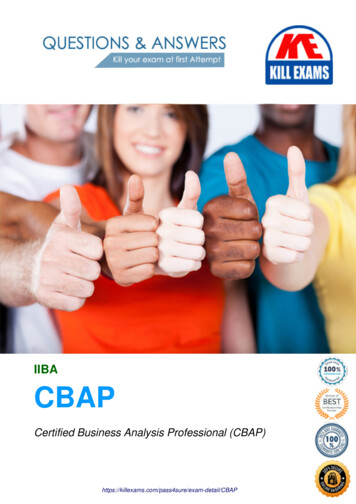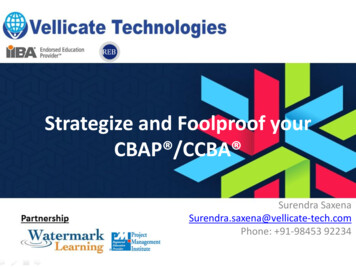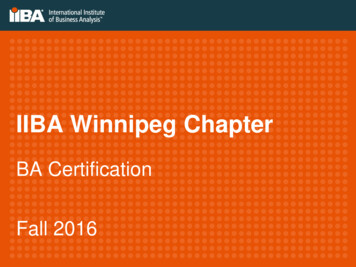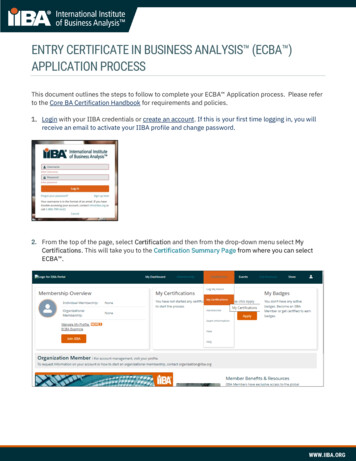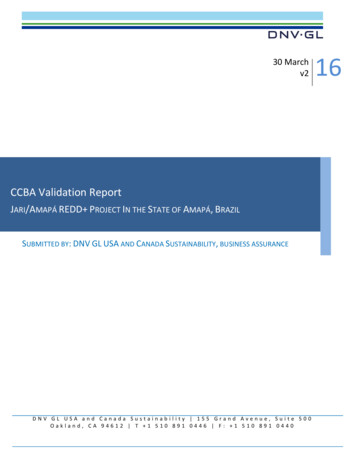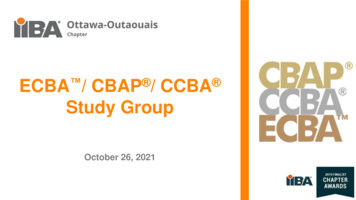
Transcription
ECBA / CBAP / CCBA Study GroupOctober 26, 2021
Agenda:15 minIntroductionMission/VisionAnnouncementsYour Hosts45 minBABOK Chapter 3: Business Analysis Planning & Monitoring15 minTechniques15 minSupplementary/Exam InfoAttendance (for PDUs)2
Your StudyGroupFacilitatorsGael Mombio, CBAPPeace IsaacVP of Professional CertificationIIBA Ottawa-Outaouais unteer, CertificationIIBA Ottawa-Outaouais Chapter3
Now let’s get to know you!ZOOM Poll1.1
Welcome from theIIBA Ottawa-Outaouais ChapterOttawa, CanadaOur Mission:To demonstrate and promote excellence inprofessional business analysis in our communityand foster an environment for engagement,learning and sharing.Our Vision:To be a strong BA community connected by acommon language and purpose whileembracing emerging trends and contributing tothe evolving role of the BA.5
SessionChapterTopic112Chapter 1: IntroductionChapter 2: BA Key Concepts23Chapter 3: BA Planning & Monitoring34Chapter 4: Elicitation & Collaboration45Chapter 5: Requirements Life Cycle Management56Chapter 6: Strategy Analysis67Chapter 7: Requirements Analysis & Design Definition78Chapter 8: Solution Evaluation89Chapter 9: Underlying Competencies910Chapter 10: Techniques1011Chapter 11: Perspectives
Need information on certification?Core BA Certification Handbook (October ication FAQs: ification-FAQs.aspx5 Things to Know Before Writing CBAP exam: rtification-exam/
Purpose of the study group To support BA certification candidates To share knowledge and understanding ofthe concepts To provide information about the IIBAcertification program To learn about the application and examprocesses To clarify content of A Guide to theBusiness Analysis Body of Knowledge (theBABOK )
Relationships Amongst the 6 BABOK Knowledge Areas (Chapter 1)
Structure of BABOK Knowledge AreaComponents (Chapter 1)Example of components of a Knowledge Area:InputInputInputsTask Purpose Description Elements Guidelines & Tools Techniques StakeholdersOutputOutputOutputs
Business AnalysisCore ConceptModel (BACCM )for Chapter 3
BABOK Chapter 3:BAPlanningandMonitoringTasks:3.1 Plan Business Analysis Approach3.2 Plan Stakeholder Engagement3.3 Plan Business Analysis Governance3.4 Plan Business Analysis InformationManagement3.5 Identify Business Analysis PerformanceImprovements
BA Planning andMonitoringInput/Output Diagram- Know all inputs andoutputs for allKnowledge Areas
3.1 Plan Business Analysis Approach
3.1 Plan Business Analysis Approach Elements– Planning Approach– Formality and Level of Detail of Business Analysis Deliverables– Business Analysis Activities– Timing of Business Analysis Work– Complexity and Risk– Acceptance
3.1 Plan Business Analysis Approach Guidelines and Tools– Expert Judgment– Methodologies and Frameworks– Business Policies
3.1 Plan Business Analysis Approach Techniques– Brainstorming– Document analysis– Functional decomposition– Lessons learned,– Etc
3.1 Plan Business Analysis Approach Stakeholders– Domain Subject Matter– Project Manager– Regulator organizations where the business analysis process isaudited.– Sponsor
3.2 Plan Stakeholder Engagement
3.2 Plan Stakeholder Engagement Elements– Perform Stakeholder Analysis (Roles, Attitudes, Decision MakingAuthority, Level of Power or Influence)– Define Stakeholder Collaboration– Stakeholder Communication Needs
3.2 Plan Stakeholder Engagement Guidelines and tools– Business Analysis Performance Assessment– Change Strategy– Current State Description
3.2 Plan Stakeholder Engagement rainstormingBusiness Rules AnalysisDocument AnalysisInterviewsLessons LearnedMind MappingOrganizational ModellingProcess ModellingRisk Analysis and ManagementScope ModellingStakeholder List, Map, or PersonasSurvey or QuestionnaireWorkshops
3.2 Plan Stakeholder Engagement Stakeholders– Customers– Domain Subject Matter Expert– End User– Project Manager– Regulator– Sponsor– Supplier
3.3 Plan Business AnalysisGovernance
3.3 Plan Business AnalysisGovernance Elements– Decision Making– Change Control Process– Plan Prioritization Approach– Plan for Approvals
3.3 Plan Business AnalysisGovernance Guidelines and tools– Business Analysis Performance Assessment– Business policies– Current State Description– Legal/Regulatory Information
3.3 Plan Business AnalysisGovernance ingDocument AnalysisInterviewsItem TrackingLessons LearnedOrganizational ModellingProcess Modelling:ReviewsSurvey or QuestionnaireWorkshops
3.3 Plan Business AnalysisGovernance Stakeholders– Domain Subject Matter– Project Manager– Regulator– Sponsor
3.4 Plan BA Information Management
3.4 Plan BA Information Management Elements– Organization of Business Analysis Information– Level of Abstraction– Plan Traceability Approach– Plan for Requirements Reuse– Storage and Access– Requirements Attributes
3.4 Plan BA Information Management Guidelines and Tools– Business Analysis Performance– Business Policies– Information Management Tools– Legal/Regulatory Information
3.4 Plan BA Information Management erviewsItem TrackingLessons LearnedMind Mapping.Process ModellingSurvey or QuestionnaireWorkshops
3.4 Plan BA Information Management Stakeholders– Domain Subject Matter Expert– Regulator– Sponsor
3.5 Identify BA Performance Improvements
3.5 Identify BA Performance Improvements Elements– Performance Analysis– Assessment Measures– Analyze Results– Recommend Actions for Improvement
3.5 Identify BA Performance Improvements Guideline and tools– Organizational Performance Standards
3.5 Identify BA Performance Improvements rainstormingInterviewsItem Tracking:Lessons Learned:Metrics and Key Performance Indicators (KPIs)Observation: used to witness business analysis performance.Process Analysis:Process Modelling:ReviewsRisk Analysis and ManagementRoot Cause AnalysisSurvey or QuestionnaireWorkshops
3.5 Identify BA Performance Improvements Stakeholders– Domain Subject Matter Experts– Project Manager– Sponsor
Zoom Poll!ZOOM Poll1.1
Techniques
Techniques About 50 Techniques in BABOK Know how BABOK uses thetechniques, not how you mightcommonly think of the technique Not all techniques are used ineach Knowledge Area or Task Know how BABOK applies thetechnique in different knowledgearea tasks
Interview Technique in Chapter 3TaskHow Interview is Used3.1 Plan Business AnalysisApproachUsed to help build the plan with an individual or small group3.2 Plan Stakeholder EngagementUsed to interact with specific stakeholders to gain more information orknowledge about stakeholder groups3.3 Plan Business AnalysisGovernanceUsed to identify possible decision-making, change control, approval, orprioritization approaches and participants with an individual or smallgroup.3.4 Plan Business AnalysisInformation ManagementUsed to help specific stakeholders uncover their business analysisinformation management needs3.5 Identify Business AnalysisPerformance ImprovementsUsed to gather assessments of business analysis performance
Interview Technique BABOK states interview technique is a systematic approachdesigned to elicit business analysis information from a personor group of people by talking to the interviewee(s), askingrelevant questions, and documenting the responses– Structured Interview: in which the interviewer has a predefined setof questions– Unstructured Interview: in which the interviewer does not have apredetermined format or order of questions. Questions may varybased on interviewee responses and interactions
Interview Technique Walking through Interview Technique in the BABOK Guide Section 10.25 Interviews (about p. 290)
BABOK Chapter 3:BAPlanningandMonitoringSupplementary Info
Get on the Chapter Mailing ListFrom the IIBA Ottawa-Outaouaishomepage, go to ottawaoutaouais.iiba.org News Newsletter ettersubscription
Study group materials are available fordownload at the Ottawa-OutaouaisChapter website– -study-groups
Questions?certification@ottawa-outaouais.iiba.org
7 Steps to Passing the CBAP or CCBA Exam#1 — Obtain and Skim the BABOK v3#2 — Apply for the Exam#3 — Read the entire BABOK #4 — Absorb the BABOK #5 — Take Practice Exam Questions#6 — Do Final Preparation#7 — Do a “Brain Dump” then Pass the AP-or-CCBA-Exam-A-Foolproof-Plan.aspx (AccessedOctober 2020)
7 Steps to Passing the CBAP or CCBA Exam#1: Obtain and Skim the BABOK v3–––––Familiarize yourself with BABOK termsUnderstanding of KAs and Tasks important for exam applicationSoftcopy free for IIBA membersHardcopy can be purchased online via retailersEndorsed Education Providers (EEPs endorsed by IIBA) mayprovide a hardcopy during certain courses, e.g. CBAP Boot Camp
7 Steps to Passing the CBAP or CCBA Exam#2: Apply for the Exam– ––––Familiarize yourself with exam prerequisites:# hrs of professional business analysis experience# hrs demonstrated experience aligned to KAs# hrs BA professional developmentMinimum high school education2 work referencesPay application feeAgree to IIBA Code of ConductSubmit application & await approval ( 21 days)NEW: Understand virtual exam requirements and connections needed(Test your connections n/#next-steps)
7 Steps to Passing the CBAP or CCBA Exam#3: Read the entire BABOK ––––Read the entire book (not necessarily in one sitting) before doingany other preparationTake notes as you goBusiness analysis is iterative and non-linear, therefore pick yourfavourite KA first then concentrate on others6 KAs / 32 tasks / 50 techniques / 5 perspectives
7 Steps to Passing the CBAP or CCBA Exam#4: Absorb the BABOK Study according to your learning style – choose a method or severalmethods that suit you:–––––––For some, reading and rereading the BABOKFor others, using a study guide (tips and tricks)For others, attending study groupsFor others, answering exam questionsFor others, attending classesFor others, individual studyConsider flash cards for BABOK terminology new to you (premade,online or homemade will do)
7 Steps to Passing the CBAP or CCBA Exam#5: Take Practice Exam Questions––––––In this phase, begin practicing examsTake numerous quizzes and examsTrack your progressRevisit KAs that you are not scoring well onConsider online exam simulatorsDo a few timed simulations to check your speed
7 Steps to Passing the CBAP or CCBA Exam#6: Do Final Preparation–––Focus on areas you have had trouble withFurther study and practice questions on these areasGet a good sleep the night before the exam:“REST WELL TEST WELL”
7 Steps to Passing the CBAP or CCBA Exam#7: Do a “Brain Dump” then Pass the ExamOn the day of the exam:––––––Eat a nutritious breakfast or lunchDrink enough water but not too muchAllow plenty of time to prepare for the virtual examTest your connections n/#next-steps)“brain dump” just before the start of the exam (inside the exam room)– helps to clear your brain, reduce test anxiety and can serve as areference during your examDon’t be intimidated by the first questions
Need information on certification?Core BA Certification Handbook (August ication FAQs: ification-FAQs.aspx5 Things to Know Before Writing CBAP exam: rtification-exam/
7 Steps to Passing the CBAP or CCBA Exam #1: Obtain and Skim the BABOK v3 - Familiarize yourself with BABOK terms - Understanding of KAs and Tasks important for exam application - Softcopy free for IIBA members - Hardcopy can be purchased online via retailers - Endorsed Education Providers (EEPs endorsed by IIBA) may
